
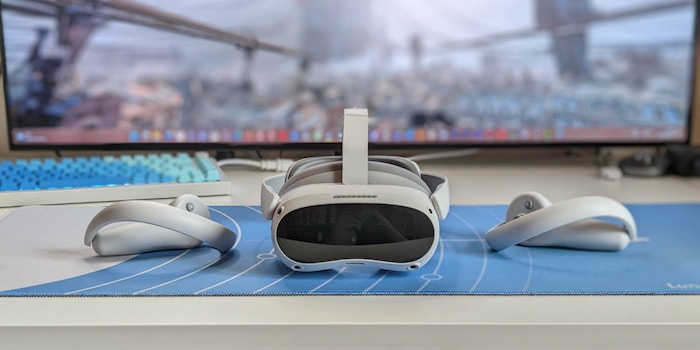
Testing the Pico 4: great VR headset if you’d rather share your data with TikTok than with Meta
The Pico 4 is the main rival of the Meta Quest 2. The standalone VR headset offers a higher resolution and a bit more field of view, but is weaker when it comes to app selection. Both of them have data protection issues.
With the launch of the PlayStation VR2, virtual reality has gained some momentum again. That’s good news, as there are great games and plenty of VR headsets out there. One of the newcomers among the standalones is the Pico 4 and was developed by Bytedance. It’s also the company behind the social media app TikTok. Admittedly, that doesn’t seem obvious, but is no reason to underestimate this VR headset.
Generously equipped and very comfortable
The Pico 4 works autonomously, without a PC or external sensors. The equivalent of a smartphone is built into the display. It allows you to install games and other apps and use them directly on the headset. In terms of features, the Pico 4 is on par with just about any VR headset out there. Here’s an overview of the most important data.
- Resolution: 2,160 × 2,160 pixels per eye
- Display: LCD
- Field of view (FOV): 105 degrees
- Refresh rate: up to 90 Hz
- Lenses: pancake
- Tracking: 6 DoF inside-out
- Audio: integrated stereo speakers
- Passthrough: colour image thanks to a 16 MP RGB camera
- Processor: Qualcomm XR2, 2.85 GHz
- RAM: 8 GB
- Memory: 128 GB or 256 GB
When it comes to resolution, not even the PlayStation VR2, with its 2,000 × 2,040 pixels per eye, can hold a candle to the Pico 4. But what’s at least as important as a sharp image is wearing comfort. Although the Pico 4’s padding is on the hard side, it’s still quite comfy. The most pressure is on my cheekbones. The weight is distributed very evenly. Standalone VR headsets are usually front-heavy because of the minicomputer that’s built into the display. Take the Meta Quest 2. It’s heavy on the neck and pulls my head back. With the Pico 4, however, I can easily play for one to two hours at a time without even a red mark on my face.
The design makes putting it on a doddle. Even easier than Sony’s new headset, in fact. I hold the display part with my right hand and the headrest with my left. The straps can be pushed up at the side by a roughly 70-degree angle, so I can put my face into the headset and then push the headrest back down. As I’ve already adjusted the Velcro on the headband as well as the twist lock on the back to fit my head, I don’t need to do any readjusting.
In terms of finish, the Pico 4 is about the same as the PlayStation VR2. While the headset comes across as a little sturdier, the controllers feel flimsier. The buttons, keys and analogue sticks are of higher quality in the PS VR2, Quest 2 and especially the Quest Pro. But the button layout is practically the same as Meta’s controllers. However, there’s one additional menu key each. The controllers sit comfortably in my hand, although the middle finger trigger could be placed a bit lower.
The 5,300 mAh battery powers through roughly three hours of gaming.
Sharp image and audio right out of the headset
The Pico 4’s equipped with so-called pancake lenses. They provide a generous range of sharpness. On the other hand, don’t let as much light through as the Fresnel lenses used in the PS VR2, for example. That model, in turn, disappoints with a picture that’s only razor sharp in a very narrow area. By contrast, you can just slip on the Pico 4 and the image is sharp every time. The correct interpupillary distance (IPD) is set in a menu that positions the lenses. I have to rely on my feeling for this. As I’m adjusting them, I long for the PS VR2 that visually indicates when the eyes are aligned thanks to its internal camera.
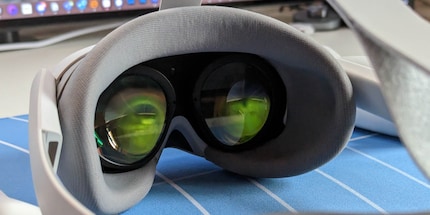
Source: Philipp Rüegg
What impressed me with the Pico 4 was how well it blocks out the light. Except for the nose area, practically no light penetrates the headset. Having said that, the Quest 2 and the PS VR 2 are a wee bit better at darkening the inside of the headset.
While I’m gaming, the Pico 4 impresses across the board. The inside-out tracking works flawlessly. The controllers allow for high-precision steering and the picture never jerks – not even when I move my head quickly. The field of view is generous, and I can easily ignore the black border that’s always visible in VR glasses. Most of the time, I streamed games from the PC. There, I can access all my purchased VR games. Not to mention that the PC versions look much better than their mobile counterparts. Streaming works really easily. All I need to do is install Pico’s streaming assistant on my PC and connect the two devices via Wi-Fi. For the display mode, I went for the highest image quality and 90 Hz. Apart from an occasional tiny stutter, it works perfectly.
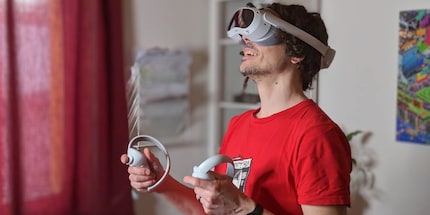
Source: Philipp Rüegg
The image quality is very good thanks to Pico 4’s high resolution. Apart from games with many dark scenes such as «Half-Life Alyx». The screen door effect really shows here. This means you can see the display in the headset and an unlit black corner will look pixelated and grey. I find this particularly noticeable, as I also own a PS VR2. It’s the only VR headset that relies on OLED instead of LCD. This makes for the highest-contrast images with the strongest colours. Plus black really is black. But since Sony’s glasses aren’t compatible with PCs, this shortcoming doesn’t carry much weight for the Pico 4.
To carry out a quick direct comparison with the Meta Quest 2, Quest Pro and PS VR2, I installed «Moss». It’s available on all platforms. The game looks a little sharper with the Pico 4 than with the Quest 2. Compared to the Quest Pro, I don’t see any difference. The Meta goggles are a tad brighter, but the contrast is a bit better with the Pico 4. The image looks best with the PS VR2. This isn’t only down to the better quality display, but also because the PS5 has the strongest hardware. In addition, the game’s rendered with more details.
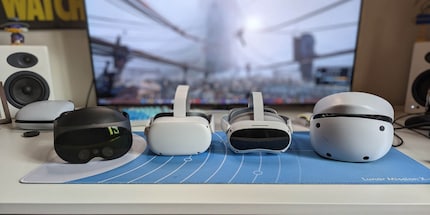
Source: Philipp Rüegg
The sound generated by the integrated speakers is perfectly fine. For a more immersive experience or to cancel outside noise, I could just wear headphones. However, this only works with Bluetooth, as there’s no headphone jack. I use my slightly dated Sennheiser Momentum 2. They work perfectly and the headphones don’t get in the way of anything. It’s a different story with the larger Astro A50. The headbands get in each other’s way.
Intuitive operation but a lack of apps
The Pico 4’s controlled almost exactly like a pair of Meta VR goggles. As soon as I start the headset up, I’m greeted by a floating menu. There, I can access the store to install apps, launch games or adjust settings. It’s the same when you’re playing a game. There are all the typical buttons you’ll find on any classic controller. In addition, there’s a home button on each side to open the Pico menu, plus a dedicated button for screenshots. The menu navigation is clear and easy to understand.
The headset itself only has three buttons – the power button on the right side and the volume buttons on the upper right side of the straps. They’re all easy to find with the headset on.
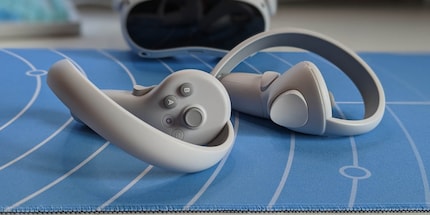
Source: Philipp Rüegg
A very useful feature is the double tap to the side of the headset. That’s how you put the Pico 4 into passthrough mode. The mode lets me view my surroundings through the glasses. This really comes in handy whenever my wife or kids need me or
I want to know if I’m about to walk into my desk. But I also have the virtual borders that help me avoid collisions. They become visible whenever I leave my defined play area. You simply draw lines on the ground with your controllers to create these borders.
I prefer the passthrough activation better than the button on the PS VR2, which you have to fumble for first. What’s more, the image is in colour – another advantage compared to Meta Quest 2 and PS VR2. The perspective is slightly distorted and everything looks a bit enlarged. In spite of this, I can easily grab things without missing.
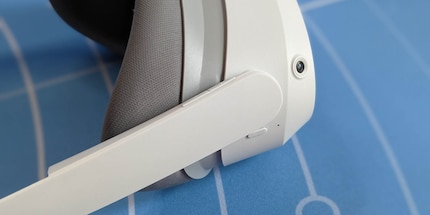
Source: Philipp Rüegg
The Pico 4 can do hand tracking. But you need to activate this option first. How? In the settings, click seven times on the software version. This unlocks developer mode. In this new menu item, you can activate hand tracking and control the VR environment without a controller.
The Pico’s main weakness is the choice of apps. It’s miles behind Meta and you’ll be looking in vain for «Star Wars: Tales from the Galaxy’s Edge», «Moss 2» or «Beat Saber». Sure, there’s the odd newer title such as «The Walking Dead: Saints & Sinners». But games have often been ported so poorly that games look less crisp than on the Quest 2. Unfortunately, the store doesn’t let you filter by game, either. That’s not the end of the world, because it’s almost exclusively games that are displayed anyway. However, the lack of game selection isn’t compensated by exclusive titles either. Here, the Pico 4 is clearly at a disadvantage. Fortunately, you still have the option to stream on your PC.
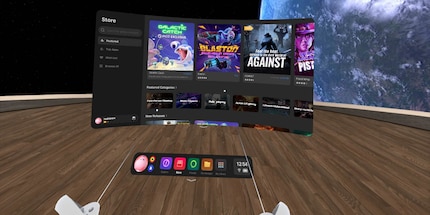
Source: Philipp Rüegg
A word about data protection
Bytedance, the company behind Pico 4 and TikTok, has often made headlines because of its data protection practices. As a reaction to this, a law was enacted in the U.S. last week that can ban apps that compromise national security. When you set up the Pico 4, you have to agree to various terms and conditions. Among other things, the T&C state that the company collects pretty much all kinds of data and behaviour patterns and also passes them on to third-party manufacturers. It’s probably safe to say that this data is also shared with the parent company Bytedance in China. If you have any concerns about this, you should avoid the VR headset like the plague – just like Meta’s Quest 2.
The lowdown: works best with a PC
The Pico 4’s a sound VR headset. The controllers sit nicely in your hand, tracking is precise and the display produces a crisp image. Operation is also well thought out. I find navigating the menus is easy from the get-go. The feature of double-tapping the headset strap twice to activate passthrough mode is a feature I wouldn’t want to miss. Another plus is how easy the Pico 4 is to put on. There’s no squeezing my head in like with the Quest Pro. Or what feels like minutes of finding the focus point like with the PS VR2. All I need to do is fold up the straps, put the headset on and I’m done. In terms of plug-and-play, it’s the most straightforward headset for me. Streaming games from the PC also works reliably and without interference.
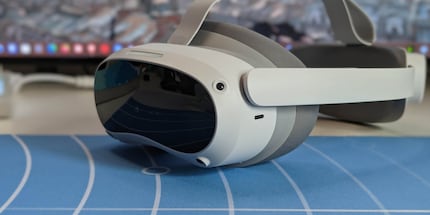
Source: Philipp Rüegg
There’s room for improvement with the padding. It’s on the hard side but still quite comfortable thanks to the good weight distribution of the Pico 4. Pico’s Achilles’ heel is, apart from the data protection concerns, the meagre selection of apps. If you plan to use the headset exclusively on its own, you’ll have to put up with a pretty small number of games and apps to choose from. In this case, I’d recommend the Quest 2. Or the Quest Pro if you’re not on a budget. Team the Pico 4 up with a PC and it really comes into force. Although the controllers aren’t quite as high-end as those of the Quest Pro, the goggles are a bit lighter. Priced at around 500 francs, there’s not much to complain about. That’s why I’ll be reaching for the Pico 4 on the PC from now on when I’m playing in VR. And I’ll continue to mourn the fact that the PS VR2 isn’t compatible with PC. In terms of image quality, Sony’s VR headset remains the unbeaten champ.
As a child, I wasn't allowed to have any consoles. It was only with the arrival of the family's 486 PC that the magical world of gaming opened up to me. Today, I'm overcompensating accordingly. Only a lack of time and money prevents me from trying out every game there is and decorating my shelf with rare retro consoles.



